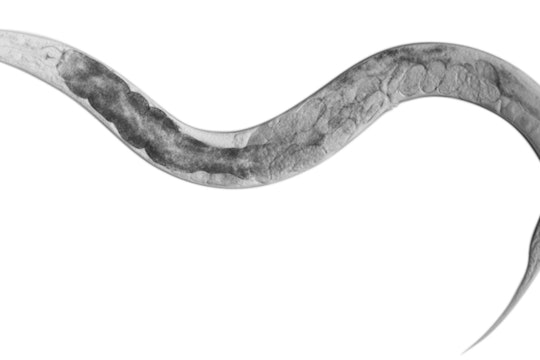
This see-through worm offers new insights into the gut-brain axis
C. elegans provides a transparent model of how bacteria and sound waves can affect the nervous system
Can you imagine being prescribed a medicinal yogurt to treat your anxiety?
Scientists at the Salk Institute are working towards just that, and their key allies in this research are microscopic worms known as Caenorhabditis elegans. Only half-of-an-eyelash in length, these nematodes have transparent bodies that allow scientists to view their inner workings. This makes them an incredibly useful and transparent model for a variety of research efforts, including how gut bacteria affects moods, and how sound waves can influence behavior. The insights they provide may yield new treatments for everything from clinical anxiety to Parkinson’s.
You really are what you eat
The gut-brain axis has become an increasingly popular field of research (and scientific buzzword) over the past decade. Researchers have found a multitude of ways that the gut can directly communicate with the rest of the body, including the nervous system.
Molly Matty, a postdoctoral fellow in the lab of Salk neuroscientist Shrek Chalasani, is researching how ingesting bacteria can affect this communication. To that end, she plans to examine how bacteria integrates into the C. elegans’ gut microbiome, and how this affects the workings of its nervous system.
“If different bacteria can alter the gut microbiome,” she posits, “could they also affect behavior through this chain of signaling to the brain?”
At the outset of her research project, Matty hopes her findings will provide a better understanding of how gut bacteria can influence behavior. The hope is that one day these helpful bacteria could be added to foods, such as yogurt, to help treat a variety of neurological conditions. The worms also happen to be inexpensive, self-replicating, and can be temporarily frozen when labs are shut down, a particularly useful feature during the coronavirus pandemic.
The Salk Institute, in La Jolla, California, is one of the many institutions that conducts cutting-edge, foundational research with C. elegans. The late geneticist Sydney Brenner (a Salk distinguished professor emeritus) pioneered the use of the worms as a model organism to study the link between genetics, cell division, organ formation and cell death, work he was awarded the Nobel Prize for in 2012.
The C. elegans has a simple nervous system with only 302 neurons, and this simplicity has allowed us to get to know it unusually well. The elegant worm was the first multicellular animal to have its whole genome sequenced. Brenner's team mapped out all its neural connections by hand over 30 years ago — the only full “connectome” we have of any animal, to this day. These insights make the worm ideal for testing new neural technologies.
A new kind of sound therapy
Salk Associate Professor Shrek Chalasani is using C. elegans to develop a novel technology called sonogenetics, which uses sound waves to non-invasively control the activity of neurons in the hopes of designing new therapies for Parkinson’s or post-traumatic stress.
“Neuroscientists are always looking for ways to influence neurons in living brains, so that we can analyze the outcome and understand both how that brain works and how to better treat brain disorders,” says Chalasani.
Chalasani’s new method can influence neurons without invasive neural probes. Instead, sonogenetics uses ultrasound, sound that is inaudible to the human ear (but audible to animals such as bats, whales, and even moths). The brain of C. elegans can sense changes in ultrasound due to a naturally occurring protein discovered by Chalasani’s team called TRP-4.
“The source of all sound is vibration, making sound a mechanical energy,” says Chalasani. “And the protein we discovered can detect changes in mechanical force.”
The sonogenetics technology works in two stages. First, the scientists use a virus to insert new genetic material into specific neurons, instructing the neurons to start producing the ultrasound-responsive proteins. Next, the researchers use a device to emit ultrasonic pulses outside of the worms, which remotely activates the neurons with the newly-produced proteins.
Thus far, Chalasani’s lab has shown that sonogenetics can be used to successfully activate neurons in C. elegans and alter the worm’s behavior (see video below).
“Ultrasound pulses could prompt the worms to change direction. These observations proved that we could use ultrasound as a new tool to study the brain, as well as potentially develop novel types of therapeutics,” says Chalasani.
Chalasani’s hope is that sonogenetics could one day be used to as a treatment for movement-related neurological disorders, like Parkinson's. With this technology, doctors could possibly activate or deactivate groups of neurons at a specific location or time to treat the disorder without brain surgery.
To learn more about postdoc researcher Molly Matty and C. elegans research, tune in to the latest season of Salk’s podcast, Where Cures Begin.

